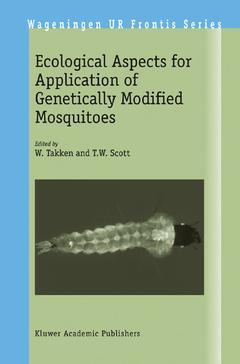Ecological Aspects for Application of Genetically Modified Mosquitoes, 2003 Wageningen UR Frontis Series, Vol. 2
Coordonnateurs : Takken W., Scott T.W.

Preface. 1. An introduction to ecological challenges concerning the use of genetically-modified mosquitoes for disease control; W. Takken, C. Boëte.
Genetic control ofmosquito-borne diseases. 2. Transgenic mosquitoes: the state of the art; D.A. O'Brochta.3. Lessons from the past: an overview of studies by the University of Maryland and the University of California, Berkeley; W.K. Reisen.4. Genetic-control trials and the ecology of Aedes aegypti at the Kenya coast; L.P. Lounibos.
Mosquitoecology. 5. May the force be with you: measuring mosquito fitness in the field; J.D. Charlwood.6. Fitness advantages in multiple blood-feeding: the Aedes aegypi example; J.D. Edman.7. Factors affecting the vectorial competence of Anopheles gambiae: a question of scale; W. Takken, S.W. Lindsay.8. Contained semi-field environments for ecological studies on transgenic African malaria vectors: benefits and constraints; B.G.J. Knols, B.N. Njiru, R.W. Mukabana, E.M.Mathenge, G.F. Killeen.
Population genetics. 9. Gene flow among populations of Anopheles gambiae: a critical review; G.C. Lanzaro, F.Tripet.10. Effective population size in relation to genetic modification of Anapheles gambiae sensu stricto; C.E. Taylor, N.C.Manoukis.
Vectors, parasites and pathogen transmission. 11. Environmental constraints on the physiology of transgenic mosquitoes; P.F. Billingsley.12. Evolution of parasite virulence to vectors; S.L.Elliot, M.W Sabelis, F.R. Adler.13. On the evolutionary ecology of mosquito immunity and the use of transgenic mosquitoes for malaria control; J.C. Koella.14.Aedes aegypti density and the risk of dengue-virus transmission; T.W. Scott, A. Morrison.
Consequencesof GMM release. 15. Release ratios employed for genetically modifying populations of mosquitoes; A. Spielman.16. Biosafety and risk assessment in the use of genetically modified mosquitoes for disease control; Y.T. Touré, A.M.J. Oduola, J. Sommerfeld, C.A. Morel.17. Measuring public-health outcomes of release of transgenic mosquitoes; C.F. Curtis.18. Discussion - Ecological challenges concerning the use of genetically mosquitoes for disease control: synthesis and future perspectives; B.G.J. Knols, T.W. Scott.
List of participants.
Date de parution : 08-2003
Ouvrage de 244 p.
15.5x23.5 cm



